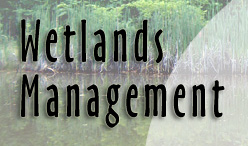|
|
|
|
|
|
Identification, delineation and mitigation |
|
Wetland soils |
|
|
|
Field indicators
of hydric soils |
page 4 of 4 |
Because most of us are not soil taxonomists, we often look for
field indicators of hydric soils. Look below for some common field
indicators.
|
|
Histic epipedon
Histic epipedons
have between 8 and 16 inches of organic material (slippery
soft, no sand)
Hydrogen sulfide odor
A strong rotten egg smell in upper 12 inches of
the soils is a good indicator of hydric soils. |
|
Histosols
(Organic soils)
These are thick dark soil with lots of organic matter
(slippery soft, no sand). If there is more than 16 inches of
organic material then you are in a peat bog.
|
| |
|
Gleyed soil
Soils that have dominant gleyed colors within 12 inches
of the mineral soil surface are considered hydric soil.
|
| |
Low chroma colors
Most hydric soil determinations are based on the presence
of low chroma colors. Soils where iron has been reduced or
removed within 12 inches of the mineral soil layer. Below
are some examples of low chroma colors indicative of hydric
soils.
* matrix chroma (0 or 1
[black or gray]) and values 4 or higher, with or without
redox concentrations (bright mottles)
* matrix chroma 2 and values 4
or higher with redox concentrations (bright mottles, chroma
3 or higher).
* Chroma 3 within 12 inches of
mineral soil surface and values 4 or higher, and more than 10% iron depletions
(chroma <2), and evidence of saturation (pore
linings, depletions) within 6 inches of the mineral soil
surface.
Chroma refers to the color
intensity of the soil. To learn more about soil color click
here.
|
|
 |
|

